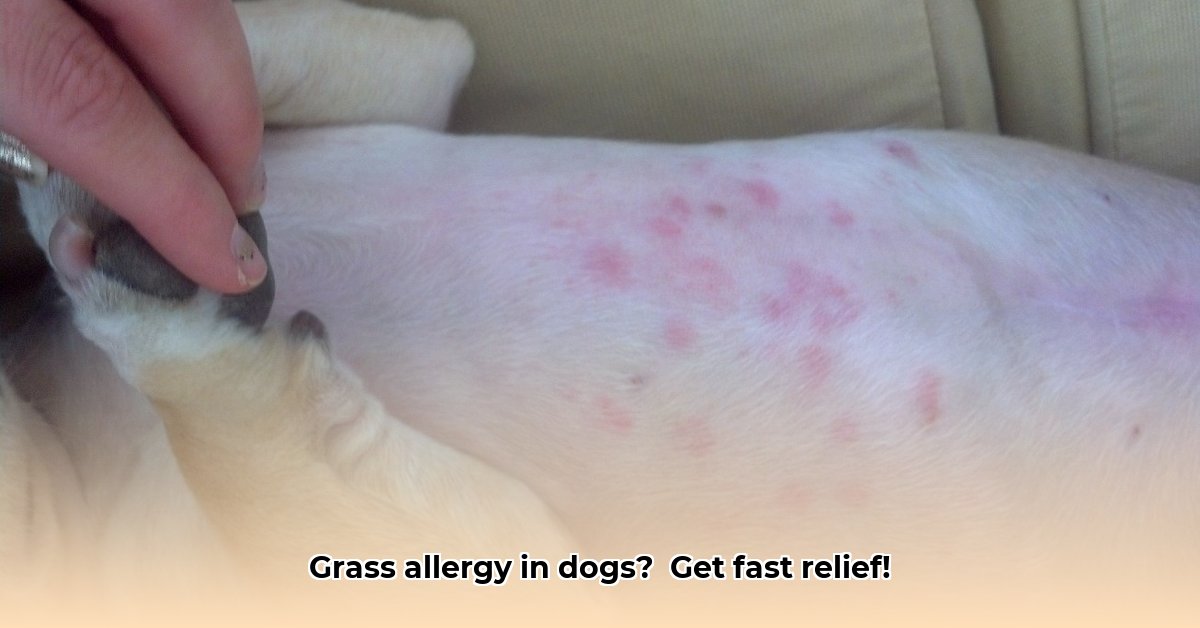Does your dog constantly scratch and sneeze after being outside? They might have a grass allergy! This guide offers practical advice to help your dog feel better, covering symptom recognition, veterinary diagnosis, treatment options (including allergy shots and special shampoos), and creating a safer home and yard. For joint support alongside allergy treatment, consider joint supplements. Let’s get your dog back to enjoying the outdoors!
Understanding Dog Grass Allergies for Quick Solutions
Dealing with a dog allergic to grass can be frustrating. This guide simplifies recognizing symptoms, getting a proper diagnosis, and finding effective relief, providing easy-to-understand and implement advice for dog owners. Learn practical ways for allergies treatment now.
Spotting the Symptoms: Recognizing Discomfort in Your Dog
Is your dog constantly scratching, especially their paws, belly, face, or ears, or showing signs of skin irritation? These are common signs of a grass allergy. Excessive licking, chewing, or even hair loss can also occur. Red, irritated skin and, in some cases, painful, infected hot spots may develop. Less common symptoms include sneezing, watery eyes, and a runny nose. In severe cases, dogs might exhibit facial swelling or hives. Severity varies from mild discomfort to significant distress. Paying attention to changes in behavior, such as restlessness or agitation, can also be helpful.
Diagnosis: Identifying the Culprit Behind Your Dog’s Allergies
A firm diagnosis is essential for effective treatment. Your vet will inquire about symptoms, history, and potential environmental triggers. A thorough physical examination will also be performed to assess the distribution and severity of skin lesions. Allergy testing, such as an intradermal skin test (injecting small allergen amounts under the skin) or a serum blood test, may be recommended. These tests pinpoint specific allergens, enabling targeted treatment. Skin scrapings or cytology may be performed to rule out secondary skin infections. While allergy testing isn’t always vital for mild cases, it’s beneficial for creating a long-term strategy.
Effective Treatment Options: Finding the Best Solution for Your Dog’s Allergy
Fortunately, multiple strategies exist for managing grass allergies in dogs. Here are the most common:
1. Medications: Your vet is the best resource for determining the correct medication and dosage.
-
Antihistamines: These drugs reduce itching and sneezing. While available over-the-counter for humans, consult your vet for appropriate use for dogs. They are typically a good starting point for mild cases. Examples include diphenhydramine and cetirizine, but not all antihistamines are safe or effective for dogs.
- Pros: Relatively inexpensive and widely accessible.
- Cons: Effectiveness varies between dogs; some may experience drowsiness or side effects. Antihistamines are generally more effective at preventing allergic reactions than treating them once they have already started.
-
Corticosteroids: More potent anti-inflammatory drugs can significantly reduce swelling and itching, especially in severe cases. Due to potential long-term side effects (increased thirst and urination, weight gain, increased risk of infection, diabetes), they’re usually for short-term relief. Examples include prednisone and dexamethasone.
- Pros: Highly effective at reducing inflammation and itching.
- Cons: Prolonged use can cause side effects; use only under veterinary supervision. Do not abruptly stop corticosteroid treatment as this can cause serious side effects.
-
Immunotherapy (Allergy Shots or Oral Drops): This long-term approach desensitizes your dog by gradually introducing small allergen amounts over time. It requires commitment and is typically administered over several years, but can provide lasting relief.
- Pros: Potential long-term solution for your dog’s allergy.
- Cons: Requires multiple vet visits over an extended period. It can take several months to see improvement.
-
Other Medications: Newer medications, such as oclacitinib (Apoquel) and lokivetmab (Cytopoint), target specific pathways involved in the allergic itch response. These can be very effective at controlling itching and inflammation with fewer side effects than corticosteroids but require a prescription.
- Pros: Effective at controlling itching and inflammation, fewer side effects than corticosteroids.
- Cons: Requires a prescription and can be more expensive than other options.
2. Environmental Controls: Reducing Exposure
Often the most effective approach, combining with medication can be helpful:
-
Limit Grass Time: Keep your dog off grassy areas, mainly during peak pollen season (spring and summer). Choose walks on paved surfaces, trails, or less grassy areas. Consider using paw protection, like dog boots, to minimize contact with allergens.
-
Regular Baths: Regularly bathe your dog with a veterinarian-recommended hypoallergenic or medicated shampoo to remove pollen and other allergens from their fur. Gentle washing avoids irritating sensitive skin. Shampoos containing oatmeal, aloe vera, or pramoxine can be particularly soothing.
-
Thorough Cleaning: Regularly cleaning your dog’s bedding, toys, and your home minimizes allergen buildup. Vacuum regularly (using a HEPA filter vacuum is ideal) and consider using allergen-reducing cleaning products. Wash bedding in hot water.
-
Air Purifiers: Use high-efficiency particulate air (HEPA) filters in your home to remove airborne allergens.
3. Dietary Considerations: While not a direct treatment for grass allergies, some vets suggest a limited-ingredient diet or a diet rich in omega-3 fatty acids might help manage related skin conditions and reduce inflammation. Discuss this with your veterinarian.
Home Care & Preventative Measures: A Daily Routine for Minimizing Reactions
Consistent daily management keeps your dog comfortable. Regular baths, grooming to remove loose hair and allergens, and thorough home cleaning are crucial steps. Wipe your dog’s paws with a damp cloth or pet wipes after spending time outdoors. Use air purifiers in your home to minimize airborne allergens. These small changes significantly improve your dog’s well-being.
When to Seek Veterinary Care: Recognizing Emergency Symptoms
Some reactions need immediate veterinary attention, including difficulty breathing, facial swelling (especially around the eyes and muzzle) (anaphylaxis), severe hives, collapse, or sudden, severe changes. Prompt treatment in these situations is crucial. Schedule a vet check-up even for relatively mild symptoms to discuss a personalized management plan—early intervention can prevent future severe issues. Your veterinarian is your best partner in managing your dog’s allergies; communication is critical.
Key Steps for Managing Your Dog’s Grass Allergies
Key Takeaways:
- Canine grass allergies are common, causing itchy skin and other symptoms.
- Veterinary diagnosis is crucial for accurate recognition and treatment.
- A combined approach of veterinary care, environmental control, and sometimes dietary changes is most effective.
- Regular veterinary checkups are essential for monitoring and adjusting treatment plans.
- Gluten Free Meal Prep Ideas for Delicious, Hassle-Free Eating - November 28, 2025
- Gluten Free Meal Prep for Stress-Free and Healthy Eating - November 27, 2025
- Quick And Easy Chicken Thigh Meal Prep For Weight Loss - November 26, 2025










